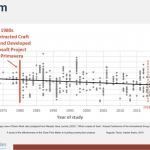(Hal Macomber, EVP, Touchplan with Connor Butler, Managing Principal, Relevate) An uninterrupted flow of value-adding work product is within the reach of every superintendent or project manager operating on the Last Planner System of Production Control®. Three new practices are necessary. First, there must be a practice for project performers to continuously update their promises and declare complete. The second practice is a system that calls attention to the action required to keep the promises that are outstanding. The third practice is the development of the project organization so people are in a position to declare breakdowns and initiate compensating action.
My 2010 Guidance on “Conducting the Project as Networks of Commitments”
A project is a single-purpose network of commitments performed by a temporary social system. Unlike recurring business processes, the networks of commitments on a project emerge rather than are designed are designed and then evolve. Networks are refined as performers have experience. Performers in a project get one shot through the network. To complicate this project performers come together as strangers. They often lack experience with each other’s reliability to perform within the network. Without the experience with each other, project performers will hold out on making their best commitments.
Your role as project leader is to activate the network of commitment on your project. Here are four actions you can take:
- Set an example of making offers (promises) that take care of the concerns and needs of project performers. People will follow your example.
- Encourage project performers to negotiate offers and promises that they can reliably deliver. Help them as needed to improve on reliability.
- Be a good customer for the promises made on your project by offering your help to performers and announcing your anticipation of completion.
- Be quick to show your appreciation for the completion of promises including being notified at completion rather than at the next project team meeting.
These actions begin to bring project performers together as team members who are taking care of each other while they take care of the project. Doing this publicly provides the basis for people to develop trust in each other’s competence and reliability to perform. And it is just the beginning. Your role as project leader requires continued attention to the functioning of the network of commitments.
Our New Guidance to “Conduct Projects as Networks of Commitments”
Project leaders must continue activating the networks of commitment as stated in my previous guidance. Collectively, the above four practices support performers to make reliable promises. I struck the above text “network of commitments emerges rather than designed.” Design occurs in a process the Lean construction community calls phase pull planning. Evolution occurs by teams managing the promises in the network with a “practice” of making commitments with the intent to improve as the project progresses.
Design and Negotiate the Conditions of Satisfaction for the Phase
Pull planning starts by defining the milestone that completes the phase. This is a collaborative conversation among the project performers for the phase. They engage with each other in the customer mindset — the next performer in the sequence is my customer. The conversation establishes a clear statement of the conditions of satisfaction (COS) that are to be achieved at the milestone.
COS are nouns and adjectives, not verbs and adverbs. We often give names to COS. For instance, two all-beef patties, Special Sauce, lettuce, cheese, pickles, onions on a sesame seed bun is a list of ingredients (nouns) that when assembled is called a Big Mac. For the construction phase that we call “overhead rough-in,” the COS may include:
- Ready for third-party inspection,
- Material installed in accordance with the building information model,
- No pipe insulation where heat trace is installed,
- Fire sprinkler capped without heads,
- Ductwork openings covered with plastic,
- Etc.
Often in Lean, we call establishing COS reaching “strong agreement on the what and how.”
Managing Promises with the Last Planner System®
The difference between the Last Planner System of Production Control® and traditional scheduling is the negotiation that can take place between the Construction Manager/Owner and the performers. Reliable promises are the responsibility of the requestors and the performers. Our aim is to agree not to commit to unrealistic requests just because a schedule says it should start. When we make promises, particularly those that we deem in the making as reliable promises, we expect that people will keep those promises. However, the future is not just uncertain, it is unknowable. Not keeping a promise might be the best action to take for the project. For instance, if the promise to install plumbing in cabinets can’t be kept due to an illness, we don’t want the countertops installed. Doing so would harm the project. We say manage the project promises to respond appropriately to the changing conditions we encounter.
Make it Easy to Update Promises and Report Completions
Managing promises starts with making it easy for project performers to continuously update their promises and report completions. This is typically done at an end-of-shift stand-up meetings with the last planners (trade partner foremen). It’s best done in the location where the phase plan work is performed. It’s done at the end-of-shift to minimize the delay or lag in sharing and responding to the day’s performance. This gives the team the time overnight to make compensating adjustments before the start of work the following morning. Other project stakeholders can know and respond to the outcomes when you electronically capture the completions and adjustments to promises along with reasons for any variation.
Develop Your System to Call Attention to Opportunities for Improvements
We also want to engage in practices that call attention to the action required to keep the promises that are outstanding. While we set out to make promises that can be kept, we can encounter unforeseen circumstances. Materials deliveries can be delayed; field conditions may be different than specified; production staff may be unavailable; equipment can breakdown; the workspace may be unavailable. And there can be a pattern to these emergent conditions. Standard practice is to measure the performers’ commitments via percent plan (promises) complete (PPC). The best practices for high-functioning networks of commitments are to measure the reliability of enabling work such as materials, RFI’s, and submittals along with investigating the promises that are missed.
Timely production data that is tracked and analyzed will aid the team to make improvements to their system and practices.
Develop the Project Organization to Take Care of Each Other and the Project
Last, we won’t hear about the problems people see and encounter if they don’t speak about them. We must develop the project organization so people are in a position to and will declare breakdowns and initiate compensating action. We use the word “breakdown” to mean any condition that would interrupt or keep us from completing a commitment. We often see trades, acting in a spirit of “minding their own business,” fail to speak about something they see about another trade’s work. We also see trades not report problems they have with their own work. Instead, they see a problem — fix the problem — move on to the next problem. The networks of commitments are fragile when those patterns prevail.
We need a no-blame, learning-first, one for all and all for one environment for high-functioning networks of commitments. Creating this starts with project leaders and trade partner supervisors and entails everyone on the project.
Closing in on Uninterrupted Flow
The combination of promising reliably, designing the milestone conditions of satisfaction, and managing promises create a basis for designing production systems that follow sound production laws and that are robust to the remaining breakdowns in the project setting. This brings us closer to the lean thinking ideal of uninterrupted flow. It’s there for your taking.
If you missed last week’s post, be sure to read Optimize the Project as a Whole If you would like to learn more about the Last Planner System®, please see Data Driven Decisions for Better Project Management or visit our case study about our work with Jacobsen.
If you would like to revisit any of the posts from the Revisiting the Five Big Ideas series, you can find all of them below.
- Part 1: Transforming the Design and Construction Industry
- Part 2: Collaborate; Really Collaborate
- Part 3: Tightly Couple Learning with Action
- Part 4: Optimize the Project as a Whole
- Part 5: Conduct Construction Projects as a Network of Commitments
- Part 6: Bring an Outward Mindset to All Interactions
- Part 7: Project Production Thinking Behind the Five Big
- Part 8: Pursue Project Outcomes at the Intersection of the Five Big Ideas
- Part 9: Adopting the Five Big Ideas on Your CM/GC Projects
- Part 10: What Comes After The Five Big Ideas?










